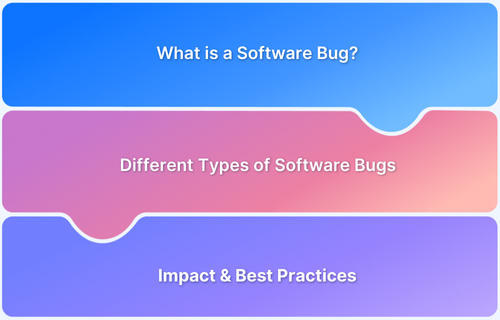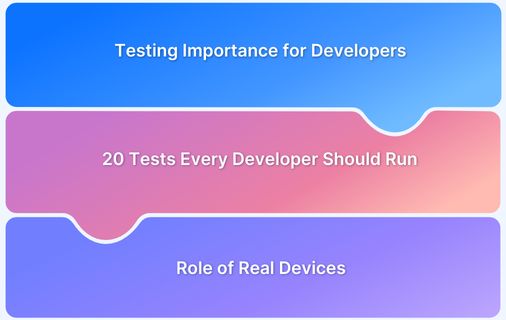Monkey testing and gorilla testing are two distinct software testing techniques used to uncover critical bugs in an application.
Monkey Testing is an unstructured testing approach where random inputs are used to check system stability and detect crashes, typically performed at the system level.
In contrast, Gorilla Testing is a structured, repetitive process focused on rigorously testing a specific module to ensure its stability and correctness, usually applied at the unit level.
This article explores both techniques, their advantages, and their specific use cases in the software testing lifecycle.
Monkey Testing vs Gorilla Testing: Key Differences
Below is a summary of the key differences between Monkey Testing and Gorilla Testing.
| Parameter | Monkey Testing | Gorilla Testing |
|---|---|---|
| Definition | Involves testing a system with random inputs, without predefined test cases, to observe system behavior and detect crashes. | Focuses on repeatedly testing a specific module with structured inputs to verify its functionality and stability. |
| Testing Approach | A form of random testing with no defined test cases. | A manual, repetitive testing process. |
| Scope | Applied to the entire system. | Conducted on specific modules. |
| Objective | Aims to check if the system crashes under unexpected conditions. | Ensures a module functions correctly without errors. |
| Who Performs It? | Can be executed by developers, testers, or end users. | Typically performed by testers and developers independently or together. |
| Types Available | Categorized into Dumb Monkey Testing, Smart Monkey Testing, and Brilliant Monkey Testing. | No specific classifications exist. |
| Testing Level | Primarily used in system testing. | Commonly used in unit testing. |
| Alternative Names | Also known as Random Testing, Fuzz Testing, or Stochastic Testing. | Referred to as Torture Testing, Fault Tolerance Testing, or Frustration Testing. |
The following sections will provide a deep dive into both techniques.
What is Monkey Testing?
Monkey testing is a testing technique in software development where a tester provides random inputs to the application without any test cases to crash the system. This technique is applied to the entire system and is used to discover bugs that otherwise would not be detected by traditional means.
Features of Monkey Testing
There are multiple benefits of Monkey Testing:
- There are no pre-determined test cases, and all the inputs are random
- It is an automated test with integrations available with popular testing tools
- It requires no planning or preparation
- The tester performing this test need not have full knowledge of the application
- It requires less time and effort
- It is used to test the reliability and performance of a system
Read More: Monkey Testing with WebdriverIO
What is Gorilla Testing?
Gorilla Testing is similar to monkey testing, the only difference being that it tests particular modules, whereas monkey testing tests the system as a whole. Each module in a product is picked and random valid and invalid inputs are fed into it until the module crashes. It is a rigorous manual test to check the robustness of an application.
Learn More: Manual Testing for Beginners
Features of Gorilla Testing
There are multiple benefits of Gorilla Testing:
- It uses random inputs and tests
- It is a rigorous repetitive, manual testing process
- It does not require pre-determined test cases
- It is used to test the robustness of a module
- It is module-specific and tests each module before moving to the next module
- It requires some preparation to test a module
Must-Read: Exploratory Testing: A Detailed Guide
Monkey Testing vs Gorilla Testing: Usage
Both Monkey Testing and Gorilla Testing play crucial roles in assessing software reliability, but they differ in approach and purpose.
- Monkey Testing assesses application performance and stability by providing random inputs, while Gorilla Testing rigorously tests individual modules with repeated inputs until they crash or prove stable.
- Monkey Testing is suitable for load testing and uncovering hidden bugs, whereas Gorilla Testing ensures the robustness of specific modules.
- Monkey Testing increases the chances of discovering unexpected errors, while Gorilla Testing verifies that all application modules function as expected.
- Monkey Testing is performed randomly across the system, while Gorilla Testing focuses on testing specific modules in-depth.
- Monkey Testing helps identify unpredictable system failures, whereas Gorilla Testing is done in the final development stages to validate module stability.
Read More: Software Testing Strategies and Approaches
Monkey Testing vs Gorilla Testing: A Comparison
Both Monkey Testing and Gorilla Testing serve different purposes and are used in different phases of software testing to ensure a system’s reliability and robustness. Here is a detailed comparison:
- Testing Approach: Monkey testing relies on unpredictable inputs, whereas gorilla testing follows a structured, repetitive approach to validate a module’s stability.
- Scope of Testing: Monkey testing covers the entire system, whereas gorilla testing is confined to specific modules.
- Objective: The goal of monkey testing is to identify system crashes, while gorilla testing aims to verify the robustness of a module.
- Execution: Monkey testing can be performed by anyone, including end users, while gorilla testing is mainly executed by developers and testers.
- Classification: Monkey testing has multiple types, including dumb, smart, and brilliant monkey testing, whereas gorilla testing does not have distinct classifications.
- Testing Level: Monkey testing is generally used in system testing, whereas gorilla testing is primarily a unit testing technique.
- Alternative Names: Monkey testing is also called random or fuzz testing, whereas gorilla testing is sometimes referred to as torture or fault tolerance testing.
Test on Real Devices with BrowserStack
For efficient and reliable testing, BrowserStack offers a real device cloud that eliminates the limitations of emulators and simulators.
With App Live for manual testing and App Automate for automated testing, teams can seamlessly verify their applications under real-world conditions.
BrowserStack supports integrations with Appium, Espresso, XCUITest, and EarlGrey, enabling faster test execution, instant debugging with text logs, video recordings, and screenshots, and ensuring robust app performance across various devices.
Conclusion
Both Monkey Testing and Gorilla Testing are valuable techniques for ensuring software quality, each with its own approach to identifying bugs and verifying system stability.
Monkey Testing helps uncover unexpected issues by providing random inputs, while Gorilla Testing rigorously evaluates individual modules for robustness.
Choosing the right method depends on the testing objectives, whether it’s discovering unpredictable failures or validating specific components. Implementing these testing strategies effectively can lead to a more stable and reliable application.







